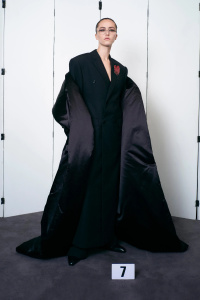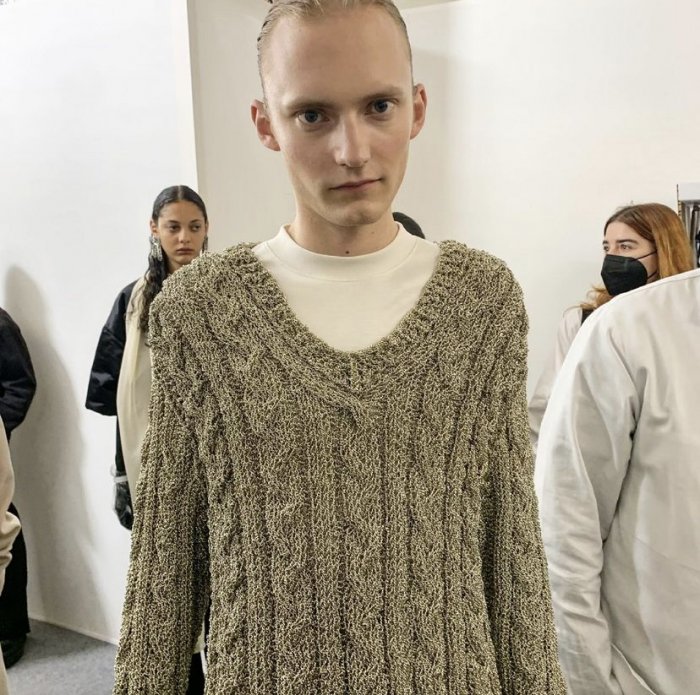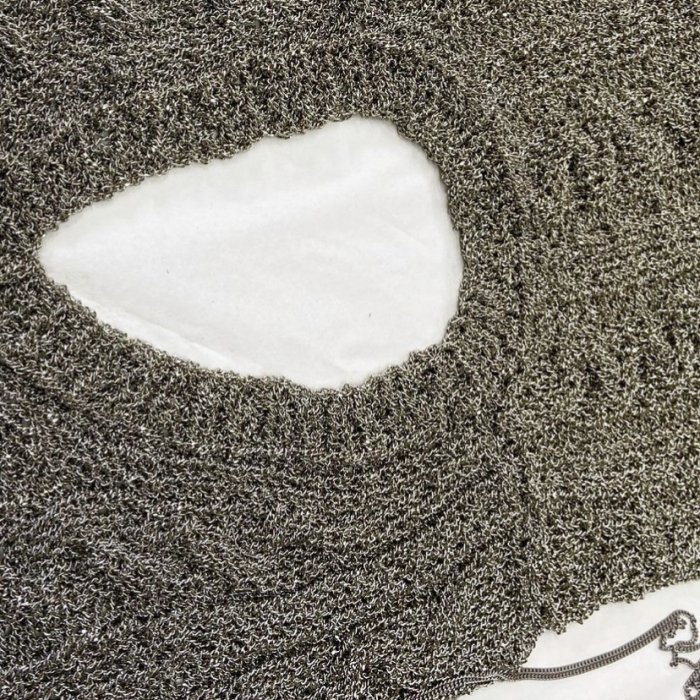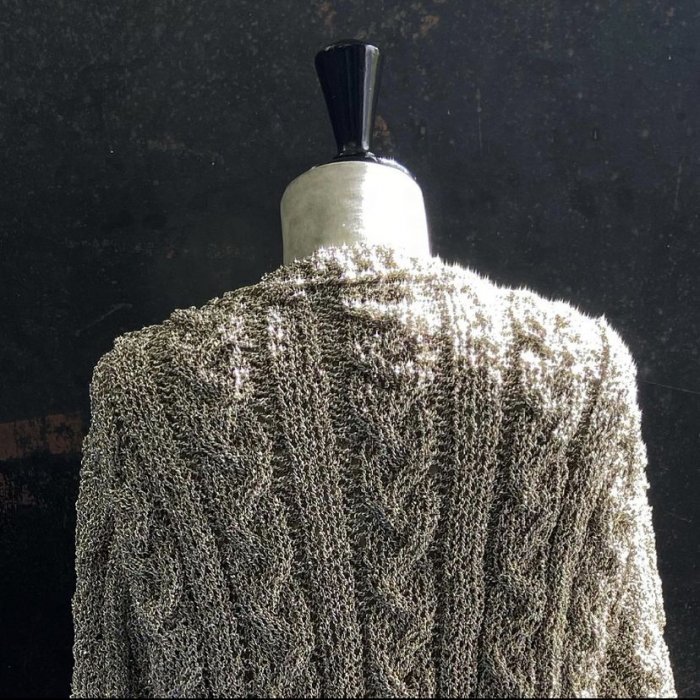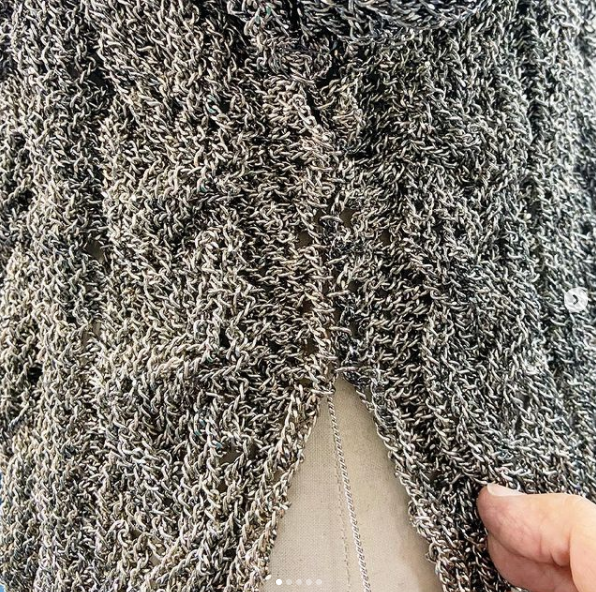Inside Balenciaga’s Couture Comeback
By Miles Socha
“I would say couture is probably the coolest thing that fashion can have a conversation about today.”
Few would argue with that declaration by
Demna Gvasalia, creative director of
Balenciaga, who is preparing to today unveil the first
Balenciaga couture collection in 53 years during a fizzy high-fashion week in Paris that has seen the return of live runway shows, international editors — and even black-tie dinners.
Look out for everything from couture-caliber T-shirts and jeans — the latter made of hand-loomed Japanese denim held together with sterling silver rivets — to fully embroidered ballgowns from Gvasalia, who recently wiped Balenciaga’s Instagram account clean to make way for a rarified collection that will surely set the fast-growing house on a new course.
“Bringing couture into the modern context and communicating it to the current audience” is how the designer described his intent. “A lot of people don’t even know that Balenciaga is a 100-plus-year-old couture brand. They think it’s a brand
that started with the Triple S sneaker. So in a way, it’s kind of educational, but also putting in the spotlight what is the most important thing about fashion, and to me couture is the purest expression of that.”
It’s also a symbolic moment for
Kering, the French group that owns Balenciaga, for it’s the first of its luxury brands to venture into the couture arena — and with what promises to be a daring and disruptive approach, echoing the famous founder Cristóbal Balenciaga, often called the couturier’s couturier.
“It’s not about looking backward, it’s about projecting fashion into the future, which is what couture has always done,” said
François-Henri Pinault, chairman and chief executive officer of
Kering, whose holdings also include Gucci, Saint Laurent, Bottega Veneta and Alexander McQueen. “Haute couture contributes to the timeless appeal of a fashion house, and particularly one like Balenciaga.”
In an exclusive interview, the luxury titan lauded couture — unlike ready-to-wear, grounded in the now — as the ultimate expression of creativity in fashion, free of the constraints of industrial production, budgets and the merchandising department, allowing new ideas, shapes and artisanal techniques to emerge.
Pinault noted that Cristóbal Balenciaga “was very avant-garde. He experimented with silhouettes, and studied their architecture.”
“Taking creative risks is always difficult. It’s something very personal,” he continued. “Yet Demna dares, after all that he has already done for the house, to continue to evolve his point of view, and to take creative risks. It’s courageous, and I treasure that.”
Pinault described a “phenomenal success” at Balenciaga since Gvasalia arrived late in 2015, partnering with CEO Cédric Charbit to revitalize the house with cutting-edge fashion shows, collections and communications. He noted that the brand powered ahead in 2020 despite the pandemic, exceeding 2019 revenue levels.
He declined to give figures, though he had signaled in 2019 that the brand would surpass the 1 billion-euro threshold that year.
“The house is very, very far from reaching its full potential,” Pinault said, characterizing the return to couture as setting the stage for a new phase of development, and enriching the brand perception, especially among young generations who might not know
the history of the house.
While Gvasalia is widely credited with igniting the streetwear craze in fashion, the designer has slyly been translating the founder’s trademark, sculptural silhouettes — barrel, balloon, sack, swing, hourglass — into modern garments like hoodies, trenchcoats and bomber jackets.
Pinault made it clear that a creative urge on the part of Gvasalia is what’s driving Balenciaga’s return to couture, one marked by a “profound respect for the codes of the house.”
Asked if other Kering brands might enter couture in the future, Pinault said: “It’s up to the artistic director of each house. There are many ways to express the creativity of a house.”
He noted that Gucci, for example, decided
to launch high jewelry in 2019, and that Saint Laurent, although born as a couture house, became famous
for pioneering and popularizing rtw in the 1960s.
At Balenciaga, Gvasalia came to Charbit with the idea to return the house to couture in 2019. He had
just stepped down from Vetements, the brand he cofounded with his brother Guram that put him on the international fashion radar, to “pursue new ventures.”
In an interview this week, he said that development was “unrelated” to his decision to take Balenciaga into couture. “But I have to say that it did liberate my time and the fact of only concentrating on one thing gave me a bit more mind space.”
More than that, the unique heritage of Balenciaga “triggered so much curiosity” about couture in the designer. “I can relate to it, I want to learn from it, and I want to bring it my vision,” he said.
The process of “restarting” the couture took about a year of legwork, according to Charbit, a curly haired dynamo of an executive whose merchandising prowess has gelled well with Gvasalia’s creativity.
It involved recruiting seamstresses and tailors, couture sales and salon directors — plus lining up specialty suppliers, which include Massaro for footwear and Huntsman for tailoring, along with embroidery houses and other ateliers.
Still, Charbit characterized it as a reboot rather than a launch, with Gvasalia’s debut billed as the 50th Balenciaga couture collection. To be sure, the house inherits the archive of a designer often called the “King of Fashion” — along with a mythic name, brand iconography and a couture-like spirit that was upheld by previous Balenciaga design directors, including Nicolas Ghesquière and
the late Josephus Thimister.
Given the brand’s legacy, it was “meaningful and significant” for skilled artisans to be approached by Balenciaga and “we had no difficulty creating a team that I think is world class,” Charbit said, though he declined to give names or detail their backgrounds.
Balenciaga had also retained its mythic address of 10 Avenue George V in Paris. Charbit and Gvasalia opted to give over this site, previously a Balenciaga boutique, and restore the couture salons to the way they were before the founder retired from fashion and closed shop in 1968. Original features include the elevator and stairs used by his illustrious clients, which included the likes of Bunny Mellon, Babe Paley, Millicent Rogers, Pauline de Rothschild, Marella Agnelli, Gloria Guinness and Mona von Bismarck.
“Demna has restored the brand’s legacy for ready-to-wear and now he’s about to do it for couture,” Charbit said in an interview. “A lot of our clients know the history of Balenciaga well, but we would like to make sure with this return to couture that the new generations understand the original creativity of the brand and the background of the house.”
While Balenciaga plans to pursue the “haute couture” appellation, which is governed by strict rules in France, it plans to show only one collection a year for women and men.
When Balenciaga announced in 2019 that it would return to the couture calendar, the house received more than 100 inquiries, and more have flown in since. Charbit said he is confident about receiving a healthy number of orders from the first show.
“We don’t have a marketing plan here. We do this as a creative mission and we do this for the future of the house,” he said. “Some of our existing retail clients have shown interest, and some of the existing couture clients have shown interest.”
He noted these could be traditional couture clients — or next-generation ones. “Just because you have an Instagram account or because you are taking selfies or because you wear sneakers doesn’t mean that you are not interested in couture,” he said. “Balenciaga has always appealed to people with a distinct, unconventional point of view.”
Moreover, “I think Demna is encapsulating the values that the customer feels strongly about today: scarcity, uniqueness, craftsmanship. Those are very modern topics,” Charbit said. “The more we have digital shows, the more we need physical shows for couture. The more we mass produce, the more we need one-of-a-kind products.”
Gvasalia said the obvious starting point for his couture debut was the archive of Cristóbal Balenciaga, so he could “understand the mindset of the founder.” But the coronavirus crisis, as terrible as it was, afforded Gvasalia more time to reconsider and tweak that approach.
“I started to question things,” he recalled in an interview. “I didn’t want it to be a tribute or look only like an homage to the heritage, because that would mean that I stay only in the past.”
And so the designer introduced his fashion vocabulary, his garment-focused approach and his inimitable way of twisting clothes into new forms and meanings. “I was not looking to find the Mona von Bismarcks of today,” he noted.
And so look out for a fusion of Balenciaga’s heritage “and the modern Demna wardrobe,” he declared.
Cristóbal Balenciaga did not make men’s wear, though he did have clothes made for himself,
which have occasionally inspired Gvasalia. For his couture debut, the starting point was a tuxedo the founder owned. Gvasalia and his team, wearing white gloves, studied the garment — its sleeves, armholes and other details about its constructions.
A strong-minded designer who frequently bends and reshapes the fashion system according to his latest thinking, Gvasalia is now putting couture “at the top of the pyramid” of his creative vision, meaning the ideas and concepts introduced there will trickle down into other product lines.
“When you work on something like this, it’s so strong that it really impacts your general creative thinking,” he mused.
The bottom of the pyramid would be his “streetwear” garments, then a more fashion-forward offering on top of his main runway collections. “Then there is a kind of a classic wardrobe, which I’m currently working on, which includes also a businesswear line,” he revealed, describing the businesswear as “a more upscale type of wardrobe, with less twists and more qualitative, and probably more expensive than the other layers underneath.”
Given that he’s felt compelled to wear long coats or suits during fittings for the couture, and not his usual jeans and loose hoodies, Gvasalia allowed that Balenciaga’s high fashion will skew dressier, though “not in a red-carpet way at all.”
“It’s really something that people can wear in their daily life,” he said, describing, for example, a denim jacket that could be worn to the supermarket, albeit one that will still look “completely glamorous and sophisticated and couture” thanks to the make, architecture and attitude.
“It puts the person, the wearer, on a pedestal almost,” he said. “That’s what couture is for me. It’s taking a mundane type of product out of the contemporary fashion wardrobe and making it special, doing that through the material, through craftsmanship, through construction, through the silhouette and all of that.”
Indeed, Gvasalia is adamant that couture can save fashion from the the tyranny of “It” bags and shoes that are only a few clicks away and worn by everyone. His last Balenciaga rtw collection for spring 2022 was
modeled by clones of artist Eliza Douglas, a critique on fashion’s obsession with trends and “hero” items, which diminishes individuality.
He’s also keen to preserve what he calls “the sacred art of making fashion — what a real tailored jacket look and feels like; what marvels haute dressmaking can produce — and to share that with younger generations.
“I have to say my favorite process in my metier is fittings, when there are scissors and pins, when we cut things and try to to sculpt the silhouette and the shape of the garment,” he said. “I’ve never enjoyed fashion as much as I have enjoyed doing this couture collection.”
The designer said he also relished the opportunity to get out of his comfort zone and learn new facets of fashion: designing embroideries, making hats and developing fabrics in exclusive colors.
Gvasalia sees haute couture as “very modern in its way of consumption” — the highest expression of buying less, but better: a powerful principle of sustainability.
“Instead of buying 20 T-shirts and bags and shoes, you put money aside for one year and you can buy one unique piece that maybe only two other people in the world have,” he suggested.
Balenciaga plans to livestream the couture show on its Instagram channel, which has 11.6 million followers, then add photographs of the looks. Going forward, the account will become “kind of like a TV channel. You know, you don’t always have the same program, so there will be a variety of things and they will appear and disappear,” the designer said.
Born in Georgia, Gvasalia studied international economics at Tbilisi State University before he enrolled in Antwerp’s Royal Academy of Fine Arts, which spawned the original Antwerp Six in the early ’80s. He graduated with a master’s degree in fashion design in 2006, later that year collaborating with Walter van Beirendonck, one of the six, on his men’s collections.
He joined Martin Margiela in 2009 after the Belgian founder retired, and was responsible for the women’s collections. In 2013, he moved over to Louis Vuitton, where he was senior designer of women’s rtw collections, initially under Marc Jacobs and briefly under Ghesquière. His Vetements project grabbed attention with its radically reconfigured, oversized streetwear and electric fashion shows, ultimately winning him the plum post at Balenciaga.
Now he is fashion’s newest couturier, and happier for it. “I have to say it’s really opened some new horizons in my creative expression,” he said.
Among those horizons is hats, for which he conscripted British milliner extraordinaire Philip Treacy.
“Hats are very important to the heritage of Balenciaga. For almost every collection, every silhouette he would have a hat,” Gvasalia marveled. “I’ve done a lot of baseball hats, but I never thought I’d work on actual hats, which is kind of a useless product, in a way. You don’t need it to survive.
“But I think the uselessness of hats is very appealing to me in the context of couture… It suddenly became such an obsessive point for me, which I enjoyed a lot.”



